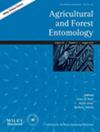水稻生态系统发展过程中植被复杂性的变化影响织网蜘蛛-猎物营养网络
IF 1.8
3区 农林科学
Q2 ENTOMOLOGY
引用次数: 0
摘要
植被复杂性和田间管理的时间变化可能会交互影响农业生态系统中捕食者-猎物网络的结构,从而改变捕食者的生物控制潜力。我们研究了作物生长过程中的植被复杂性和管理类型(常规管理与有机管理)如何影响泰国南部雨水灌溉低地水稻生态系统中球织蜘蛛及其猎物的营养网络。具体而言,我们研究了织眶蜘蛛与猎物的组成、猎物选择性和网络结构。总体而言,织眶蜘蛛捕获的主要是与碎屑相关的双翅目、与水生相关的蜉蝣目和半翅目害虫。水稻生长过程中植被复杂性的增加极大地调整了织眶蜘蛛与猎物的网络结构,而田间管理的影响微乎其微。我们的研究结果表明,在水稻生长后期,增加每个猎物分类群的蜘蛛种类数量(猎物脆弱性)可能会加强蜘蛛对包括水稻害虫在内的猎物的自上而下的控制。本研究还强调,在水稻生长季节,随着植被变得更加复杂,水稻生态系统的网络复杂性和稳定性也在增加。未来的实践可以寻找一种方法,在水稻生长早期支持碎屑和水生昆虫的密度,并人为增加栖息地的复杂性,以改善织眶蜘蛛提供的生物防治服务。本文章由计算机程序翻译,如有差异,请以英文原文为准。

Changes in vegetation complexity during the development of rice ecosystems affect orb-weaving spider-prey trophic networks
求助全文
通过发布文献求助,成功后即可免费获取论文全文。
去求助
来源期刊

Agricultural and Forest Entomology
农林科学-昆虫学
CiteScore
3.60
自引率
6.20%
发文量
66
审稿时长
>24 weeks
期刊介绍:
Agricultural and Forest Entomology provides a multi-disciplinary and international forum in which researchers can present their work on all aspects of agricultural and forest entomology to other researchers, policy makers and professionals.
The Journal welcomes primary research papers, reviews and short communications on entomological research relevant to the control of insect and other arthropod pests. We invite high quality original research papers on the biology, population dynamics, impact and management of pests of the full range of forest, agricultural and horticultural crops.
 求助内容:
求助内容: 应助结果提醒方式:
应助结果提醒方式:


